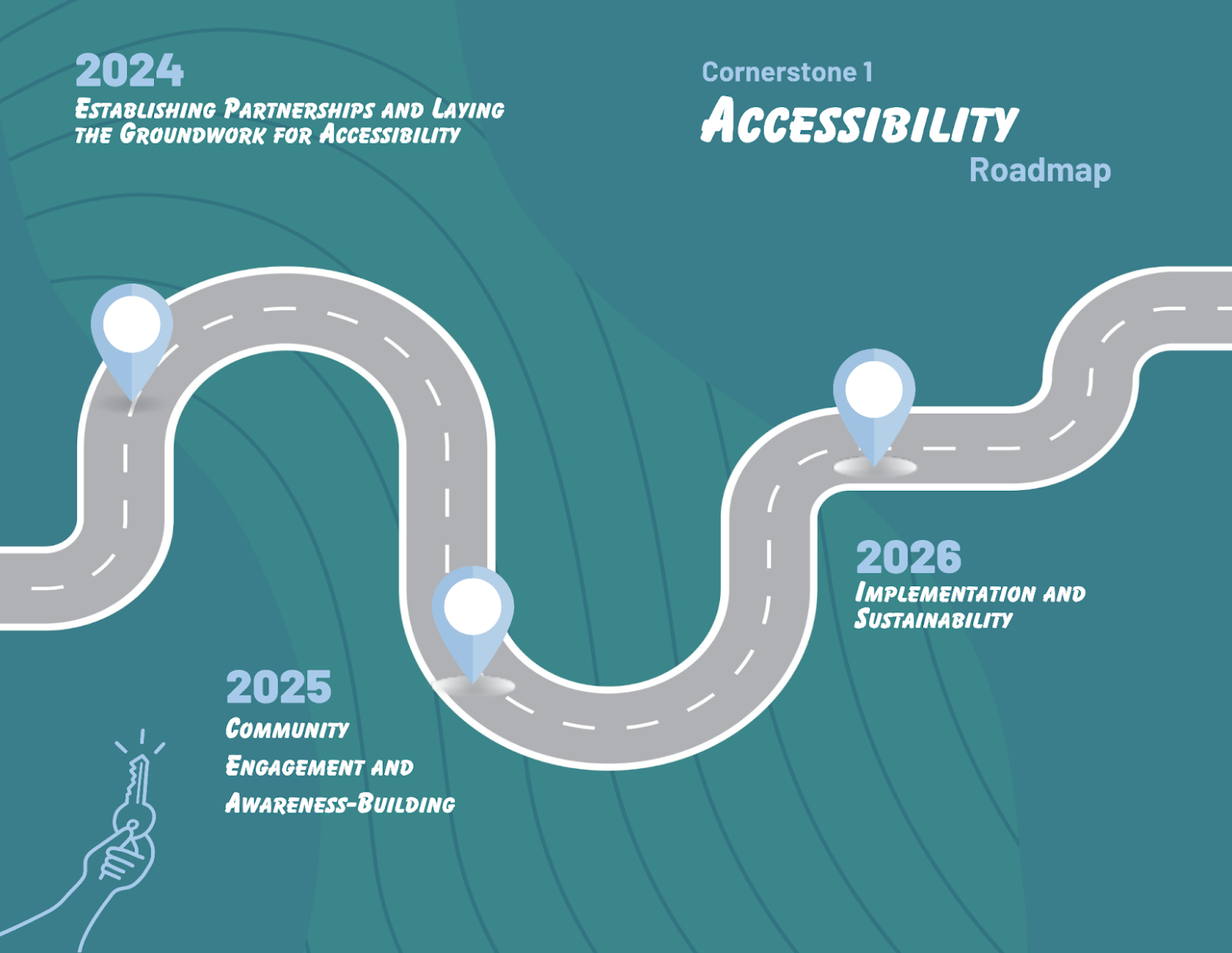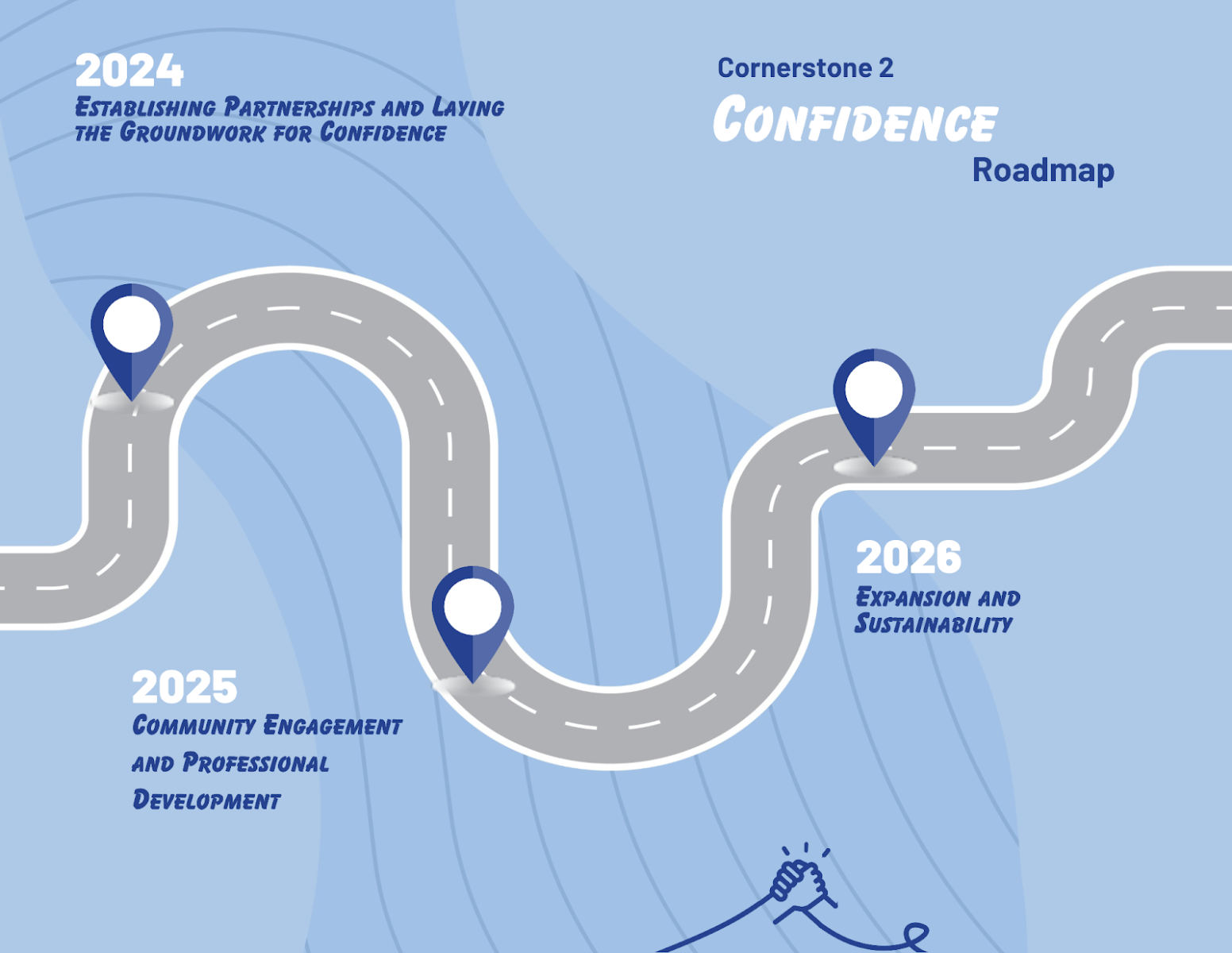When digital equity is achieved, opportunity follows. It means residents can access better-paying jobs, pursue online education and training, grow small businesses, connect with loved ones, and access critical health, financial, and government services. It unlocks new pathways for innovation, creativity, and civic participation—especially for those historically left behind by the digital divide. In Cook County, we see digital equity as a catalyst for economic growth, educational advancement, and community well-being. By investing in infrastructure, devices, skills-building, and trust, we are laying the groundwork for a future where everyone—not just the connected few—can benefit from and contribute to a thriving digital economy.
The 4 Cornerstones of Digital Equity
The four cornerstones of digital equity are:
- Accessibility,
- Confidence,
- Safety, and
- Infrastructure.
IMPACT Solutions
For each of the four cornerstones, the plan proposes a set of IMPACT Solutions to be undertaken through collaborations between Cook County Government and regional partners.
IMPACT stands for: Innovative | Measurable | Purposeful | Actionable | Collaborative | Timely
Each of these solutions is designed to be impactful right now and in the long term, to address the intersection of diverse community needs, and to lay the groundwork for long-term success. Learn more about each of the cornerstones and IMPACT Solutions below.
Cornerstone 1: Accessibility

IMPACT Solutions
Cook County will conduct outreach in partnership with community-based organizations and agencies already supporting residents in other ways—such as schools, affordable housing, and social service providers—to support residents in enrolling in subsidized internet programs like the Affordable Connectivity Program and other low-cost internet plans. Cook County will also seek to support the Illinois Office of Broadband as it develops low-cost internet solutions. Expanding outreach for enrollment, especially offline and in established social networks, will help direct these existing benefits to County residents to bring internet access within reach. Finally, Cook County will coordinate with the City of Chicago and State of Illinois to advocate that internet service providers address eligibility requirements that lock people in need out of low-cost plans, and to encourage additional partners to create new low-cost plan solutions.
Cook County will leverage existing resources, including building from County fiber resources where possible, to provide bandwidth for homegrown public Wi-Fi networks throughout Cook County. Public Wi-Fi and home connections can be built and managed by small ISPs and even libraries, churches, schools, hospitals, and other community anchor institutions. Ideally, these expanded networks will allow for in-home use, increasing the privacy experience for those on a public network. Cook County will also partner with organizations to encourage the creation of a Digital Stewardship program to train residents as Wi-Fi installers and community network managers. Digital Stewardship, a model piloted in Detroit, New York City, Seattle, and rural Tennessee, trains community residents as the stewards of technologies for their communities, including through building, maintaining, and expanding local Wi-Fi services.
Cook County will work to drive innovative solutions for expanded access to high-quality devices through partnerships with schools, libraries, and community-based organizations that provide digital skills training. Cook County is looking to develop a device voucher/trade-in program supported through public-private partnerships and existing device access programs. It is also considering a Learn-to-Earn program supported by program providers (libraries, schools, higher education). These programs will consider eligibility criteria beyond poverty status so that more people can access devices. Cook County will identify and support partner organizations with a focus on device access and device maintenance, and will work to grow this network to ensure capacity throughout suburban Cook County.
Cornerstone 2: Confidence

IMPACT Solutions
Cook County and its partners will participate in and support a corps of Digital Navigators focused on digital skills learning, tech support, and internet safety and security, currently being led by the State. Digital Navigators will provide high-quality one-on-one support and assistance to community members and to lead classes and workshops on topics of interest. For example, Digital Navigators may be specifically focused on supporting young people, seniors, or non-English speakers.
Cook County will take a community-by-community approach to grow the digital equity learning ecosystem. This starts with developing an asset map that includes people, places, and spaces that advance digital equity at the community level. From there, Cook County will facilitate and provide technical assistance to cities, coalitions, and nonprofits as they develop digital equity micro-plans. Micro-plans may be used to identify and support both new and existing digital skill providers to address the digital skill needs and interests of each community. Cook County will also support and grow the ecosystem within County government by identifying all digital equity related projects within County departments and assessing them for alignment with this plan and best practices. The County will continue to work with its Bureau of Human Resources and Bureau of Technology on digital skill trainings and programming for County employees.
In order to support the Workforce of the Future, Cook County can support opportunities for digital upskilling and create partnerships that encourage pathways to good tech-related jobs. Opportunities may include pilot programs to teach cutting-edge digital skills for work, such as software as a service, network administration, artificial intelligence, robotics, and mixed reality. Plus, Cook County can partner with workforce development organizations to encourage and provide paid internships, externships, and apprenticeships for participants from digital equity programs to gain work experience and pathways to employment.
Cornerstone 3: Safety

IMPACT Solutions
Cook County plans to bring partners and social service providers together in order to explore a Digital Safety Help Line model, which could be staffed by Digital Navigator programs. Partnerships can also be formed with entities IMPACT SOLUTION: DIGITAL SAFETY HELP LINE OPERATED BY COMMUNITY HELPDESKS who work with specific at-risk populations, including refugees, youth, unhoused, and domestic violence survivors so that the Helpline is equipped to support the diverse needs of the community.
Cook County will work to provide expertise and information to the public, through skill-building opportunities, communications, or campaigns, about safety and security. That information may include: • Protecting ourselves, protecting each other: talking about safety concerns and strategies • Understanding and stopping the spread of mis- and disinformation • What’s in my wallet: Understanding the data we share in financial transactions • Protecting our mental health and managing tech-related trauma, including online racism and violence
Cook County will increase communications about digital safety and specific threats to its residents, including phishing schemes, online scams, and consumer advisories that can be amplified from the Federal Communications Commission. Cook County can also share tips for mitigating and reporting online threats as well as concrete steps to take to address threats.
Cornerstone 4: Infrastructure

IMPACT Solutions
Cook County recently completed the first phase of its current broadband expansion efforts, which connect several municipal anchor institutions in this region to high-speed broadband, including the Palos Heights Police Department, Tinley Park Public Works, Moraine Valley Community College, Thornton School District 154 and others (Cook County, 2023). Cook County can leverage its own infrastructure to attract new partners for last-mile access, and to support the Chicago Southland Fiber Network and HACC Broadband Expansion projects (Tate, 2023). Cook County is evaluating public-private-partnership ideas to leverage this infrastructure to provide service to residents. For example, Cook County can make its network open access to allow local internet providers to use or allow partners to build community Wi-Fi using existing infrastructure. To identify innovative ways to expand the network, Cook County and its partners will work to: conduct market sounding with broadband providers to see how they can leverage the infrastructure to provide residential access; connect additional anchor institutions; and research funding programs and connect with state officials about forthcoming opportunities. Cook County and its partners can also crowdsource examples of innovative projects across Cook County or elsewhere that could be replicated or expanded, and develop technical assistance resources for communities seeking solutions.
Many locations in Cook County are shown as “served” on all provider data submitted to the Federal Communications Commission, but that is often not people’s experience. Poor performance is common in areas where internet providers have not upgraded infrastructure or have stopped maintaining legacy infrastructure like copper digital subscriber lines (DSL). Mapping efforts are underway to try to resolve this data inconsistency, both at the local and state level, and nationally as part of the mandate of the Infrastructure Investment and Jobs Act of 2021. This process is iterative and relies on careful data collection and refinement to provide the clearest picture of infrastructure availability possible. As Cook County maps our local infrastructure, it will interact and contribute to other mapping efforts to validate findings. The County and its partners may also consider running a local public challenge process where residents can report their internet conditions to further refine and validate data provided by internet providers. As part of this effort, Cook County and its partners will work with municipal governments and school districts to take stock of assets like buildings, poles, and conduit that can be potentially used for expanding broadband infrastructure; align with state and city efforts; and leverage a public map challenge process to understand pockets of need and poor service, and to check available maps and data for accuracy.
Community Conversation participants asked for public agencies to take a more active oversight role in improving infrastructure in underserved areas, addressing poor service due to a lack of competition, and ensuring that plans offered under internet affordability programs are of high quality. The County can advocate with other government stakeholders and the industry in order to encourage accountability for pricing and service commitments, including meeting established standards for service and privacy. Cook County and its partners will also invest in the ecosystem described in this plan to educate residents about service providers and broadband systems.
Data Dashboard
Engagement
3,179
Completed
Surveys
814
Conversations with
Community Members
49
Outreach
Events
Accessibility
1,799
Devices
Distributed
15,757
Computer
Lab Users
Safety
132
Training
Workshops
1,145
Individuals
Trained
Confidence
161
Training
Workshops
615
Individuals
Trained
Infrastructure
728
High-Touch
BEAD Engagements
1,823
Light-Touch
BEAD Engagements

